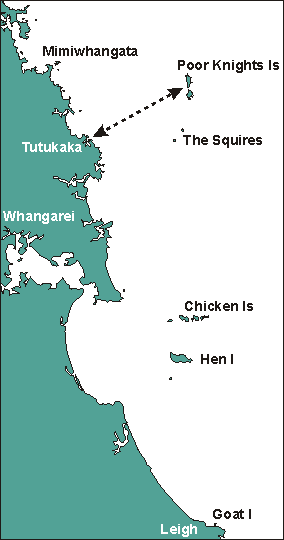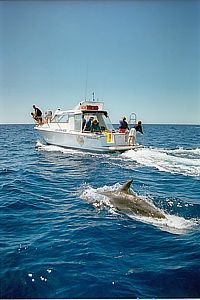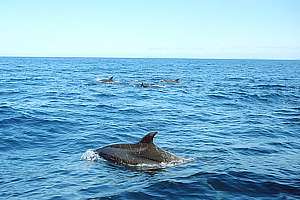

| Introduction to this very large section, and how to find your way around. (on this page, 7p) | ||
| The recent history of the Poor Knights, from its Maori habitation to today. (3p) | ||
| The geology, biogeography and ecology of the Poor Knights, or how to understand its diverse environments. (14p) | ||
|
plants&animals
|
|
|
|
diving
|
The many dive sites are described in four sections, going from north
to south, each with a detailed map.
|
|
|
adventures
|
The Poor Knights provide a life-time of diving adventures, if only
one knew what to look for.
|
|
|
maps and more
|
You are authorised to use our maps of the Poor Knights
for personal use (see rights page). For
best results, save the image to your local disk and print it using a photo
editing program. The Graphic Internet File (GIF) format preserves sharpness
and colour, and is very compact.
|
|
|
related chapters
on this web site |
|
|
| Books and references (on this page) | ||
| A log of recent changes to this section (on this page) |

View of the Poor Knights from the south-west, as visitors approach from Tutukaka. For many divers this is the point where adrenaline begins pumping. On left the northern island Tawhiti Rahi, in the middle the southern island Aorangi Island and on right Archway Island with Aorangaia Island behind it. |
Note! for best printed results, read tips
for printing. For corrections and suggestions, e-mail
the author.
The whole section covers about MB, including text, drawings
and photographs. Buy our CD or
make
a donation.
-- Seafriends home -- index
to marine reserves in NZ -- Rev:20071001,
Introduction
 The
Poor Knights Islands are located in the northernmost part of New Zealand,
called Northland. The map shows the coast north of Auckland, which lies
about 90km south of Leigh. In Leigh is New Zealand's first marine reserve,
that around Goat Island. Recently a small marine reserve has been created
at the entrance to the Whangarei Harbour, and the next one further north
is around the Poor Knights Islands. Taking a coastal road from Whangarei,
one arrives in the picturesque and sheltered harbour of Tutukaka, where
many yachts and charter boats are berthed. Dive charters take divers from
Tutukaka in a north-easterly direction to the Poor Knights. The
Poor Knights Islands are located in the northernmost part of New Zealand,
called Northland. The map shows the coast north of Auckland, which lies
about 90km south of Leigh. In Leigh is New Zealand's first marine reserve,
that around Goat Island. Recently a small marine reserve has been created
at the entrance to the Whangarei Harbour, and the next one further north
is around the Poor Knights Islands. Taking a coastal road from Whangarei,
one arrives in the picturesque and sheltered harbour of Tutukaka, where
many yachts and charter boats are berthed. Dive charters take divers from
Tutukaka in a north-easterly direction to the Poor Knights.
Slightly further north of the Poor Knights, on the coast is another marine reserve, that around Mimiwhangata. This reserve is not fully protected, allowing recreational fishing, and is therefor called a marine park. Just west of Mimiwhangata is the coastal township of Oakura from where some charter boats operate, also taking divers to the Poor Knights. Further north, outside the map is the Bay of Islands, and further north still, the deep harbour of Whangaroa. The Poor Knights provide the best diving in New Zealand, because they are located far out in sea, near the edge of the continental shelf, surrounded by deep clear water exceeding 100m depth (300FT). Being the hard volcanic remnants of what was once a large volcano, the Poor Knights have steep cliffs and steep drop-offs underwater. The volcanic rock has many adventurous caves, archways and passages. The Poor Knights are easily reached from the nearby safe harbour of Tutukaka, where fast dive boats take visitors to the islands within an hour. The rohe (traditional grounds) of the Ngatiwai tribe extend from Cape Brett, just north of the map to Tawharanui, just south of the map and includes all islands in the sea, including Little Barrier I (east of Goat I), and parts of Great Barrier I (far east of Goat I). |
Why are the Poor Knights so highly valued?
 |
 f200120: left photo: the charter boat has slowed down to allow bottlenose dolphins to ride its bow wave, while divers look on. |
Since 1998 the Poor Knights have become a fully protected marine reserve, which means that one cannot take anything home or damage the environment. The Poor Knights have for a long time a totally protected terrestrial reserve on which nobody is allowed to land without a permit. Permits are given only if one can show that one's presence is of important benefit to the islands.
Because of this high standard of protection, it is hoped that the underwater
environment will improve even beyond what it is today. Unfortunately, as
you will read in the chapter on degradation, a new
threat has appeared, for which marine protection cannot help.
| Rules and regulations
Navigation and mooring is permitted within the Poor Knights Marine Reserve. While landing on the Islands is prohibited, the marine reserve around them is yours to enjoy, provided you observe the rules and follow environmental care code. In the interests of preserving the environment and retrieving your anchor, please use the minimum of chain necessary. Visitors to the marine reserve are welcome and activities like boating, snorkelling, scuba diving and canoeing are encouraged. However a number of other activities are prohibited to protect the marine life of the area.
Commercial fishing is prohibited in the marine reserve and MAF regulations also state: (i) No commercial fishing except long lining is permitted within three nautical miles of the islands, and (ii) No commercial fishing (all methods) is permitted within one nautical mile (5,556 metres) of the Islands. Nature reserve rules
These rules are to protect the Islands from fire and the accidental introduction of pests like rats or cats and invasive weeds. Any one of these could result in an ecological catastrophe for the islands and the species that survive on them. Vessel ban
|
| Ngatiwai are an ancient people who were known as Ngatiwai ki te Moana (those who lived along the east coast and offshore islands) and Ngatiwai ki te tua Whenua (those who lived inland e.g. Ngatihine). Ngatiwai descend from Manaia, Tamatea and Tahuhunuioterangi. The mana of Ngatiwai is water and this is remembered by Manaia saying to his descendants, "Although you stand on land, you stand also in the sea." Ngatiwai occupies the shoreline from Motukokako (Cape Brett) to Tawharanui (south of Cape Rodney) to Aotea (Great Barrier Island). They also occupied many islands including Tawhitirahi and Aorangi (Poor Knights). They are the kaitiaki (guardians) of a sacred covenant placed on the islands by the ringa kaha Te Tatua (chief) in 1822. This tapu was placed following the massacre of his people while he and his warriors were absent. It also covers the surrounding waters because some of the occupants had jumped the cliffs to avoid being taken prisoner of the invaders. Ngatiwai fully supports the marine reserve and considers it to be a small step in the right direction of protecting the significant tapu over these islands and surrounding waters. Ngatiwai request that visitors respect the area and hope you enjoy your visit. |
This very large section about the Poor Knights islands was written to document this unique place such that visitors will be better prepared and New Zealanders able to learn about this magical place. On the Seafriends web site we have also documented other marine reserves, and the Poor Knights fill an important gap on the transect Leigh (Goat Island) - Poor Knights - Kermadecs - Niue, documenting marine environments from coastal green to cool-tropical deep blue water.
| About this section
As you may guess from the extensive contents index above, this section about the Poor Knights is very large (over 160 pages with over 450 images). It also provides a richly illustrated and accurate map of places of interest, which ties everything together. The co-ordinates of the map have been verified, and in many cases precise GPS co-ordinates have been provided. All dive sites have been tested, and depths verified. Even so, the underwater environment of the Poor Knights will probably remain a mystery forever. |
A common thread through the many chapters on the Seafriends web site (www.seafriends.org.nz) is the fostering of understanding of the weird marine environment. If we want to save the sea, we must understand how it works, and for this understanding we must also experience the sea from a diver's perspective - what it looks like, its adventures, its mysteries, its many habitats and species. In other words, we aim to bring the sea to the surface, for all to see and enjoy.
In the history of the islands, we have been able to consult many sources, which enabled us to piece a picture together of the Maori settlement and later European management.
The chapter on the ecology of the islands, begins with its ancient geological history and how this has resulted in the islands we know today. The chapter on ecology deals mainly with the islands' marine environment, because this is the place that interests us most. For the reader it provides the key to understanding what lives where and why. Separate chapters have been devoted to the mystery of Barren Arch, the mysteries of Rikoriko and the awesome Taravana Cave. Even those who are very familiar with the Poor Knights, may find these chapters astounding and challenging.
The most important chapters for divers describe the many dive locations in four parts, from the northernmost quarter to the southernmost. Most dive sites are illustrated with photographs above and under water. North, mid-north, mid-south, south, squires.
Separate chapters have been devoted to snorkelling and nightdiving with valuable tips and advice. Beginners may wish to learn the advanced techniques of snorkelling without fear.
One can never document all marine creatures found at the Poor Knights, so we have limited ourselves to the most common ones, still a very respectable number. The legendary schooling fish and awesome moray eels deserved a chapter of their own, as well as the socialising stingrays.
The many remaining organisms were organised in three chapters: the fishes, the cliff dwellers and the seaweeds. The chapter about reef fishes was not arranged in taxonomical order but according to where they are found. As far as the cliff dwellers go, we had to limit ourselves severely, and not with an apology either. The Poor Knights' sessile life is simply too varied, and remains therefore an inexhaustible source of enjoyment. Also the seaweeds have been left largely untouched for the same reason.
A sad but necessary chapter Going, going, gone
is devoted to the marine degradation that is now encroaching on the Poor
Knights. Long hushed up for commercial and political reasons, it has had
disastrous consequences that are now clear to for anyone see. The sea is
sick and marine reserves do nothing to prevent or mitigate the loss of
both quality and quantity of life. Only by
saving the land can we save the sea!
You may now be interested to read more about marine degradation affecting
New Zealand's coastal seas. Begin with the samples
of decay. Note that this is the ONLY place in the world where you can
read about the principles of degradation,
the plankton balance hypothesis
and the Dark Decay Assay with which
the six most important ecological laws
on this planet were discovered (!!). Only reading is believing. (large
chapters)
The many links to related chapters on this web site are all worth pursuing in your quest to begin to understand the sea. Visit the Seafriends home page, the recent additions , the big overview and the very extensive and complete sitemap that also shows what is still missing.
This large chapter about the Poor Knights did not happen overnight,
but is the result of decades of preparation, study, photography and observation.
I hope that it will not remain an effort just by myself, but that others
may contribute with valuable knowledge, corrections and suggestions. In
this manner these pages can remain alive and uptodate. - Floor Anthoni.
| Further reading
References in blue are available from the Seafriends Library
|
| Internet links:
www.wadedoak.com/ Wade's World: the web site of veteran diver, photographer and prolific writer Wade Doak enables you to purchase many of his books on CD as well as underwater photographs. www.doc.govt.nz/ The official web site of the Department Of Conservation contains a small chapter about the Poor Knights marine reserve. This site is rather messy, so you'll need to find it from the home page. http://www.goodearthgraphics.com/virtcave/seacaves/riko_only.pdf an account of the Rikoriko cave survey for size. (3p) |